Abstract
In order to sustain food production under conditions of limited water and in arid regions using the least amount of irrigation water possible, two experiments were conducted during the years 2021 and 2022 in the Nubaria region, Egypt. The performance of an automated drip irrigation control system was evaluated as a potentially efficient and sustainable alternative to manual irrigation to increase the fertilization frequency (N P K) of lemon trees. This study underlines the importance of automatically applying and controlling the addition of irrigation water as a sustainable alternative to manual irrigation, while increasing the number of mineral fertilization times under sandy soil conditions to the largest possible number (12 times during the growing season of lemon trees) instead of three times. The application of automatic irrigation reduced the water stress on the roots of the lemon trees, in addition to increasing the efficiency of the addition. The latter led to the creation of a healthy environment in the area where the roots spread and increased the rate of absorption of irrigation water loaded with the necessary major elements, thus increasing the canopy volume of the lemon trees. This, in turn, led to an improvement in the efficiency of the photosynthesis process, resulting in an increase in the productivity, water productivity, and quality characteristics of lemon in sandy soil in dry areas. Increasing the number of times of mineral fertilization to 12 during the growing season led to a long-term increase in the concentrations of those minerals within the area of root spread, avoiding losing them by deep percolation, as occurs fertilization is carried out only three times per season. The highest values of the productivity and irrigation water saving were 47.6% and 47.4%, respectively, during the first season and 48.7% and 48.8%, respectively, during the second season. The highest values of water productivity and lemon fruit quality were also achieved under the same conditions. Therefore, this study recommends the automatic control of irrigation schedules, in addition to increasing the frequency of fertilization times, not only in lemon plantations, but also with most horticultural fruit trees grown in dry sandy lands.
1. Introduction
One of the most significant issues facing Egypt’s agricultural crop production is the reduction of water consumption in irrigation [1]. To adapt to this situation, new approaches and strategies must be devised [2,3]. The gap between crop productivity and the demands of a growing population can be narrowed by enhancing and modernizing agricultural practices in arid regions, such as through irrigation methodologies [4]. Water productivity (WP) for agricultural crops is essential in Egypt due to the scarcity of water resources in arid regions. Water scarcity is the main cause of low crop production worldwide [5,6]. Because of this, it is critical to use irrigation water effectively and to apply under-irrigation principles with the smallest possible loss of yield [7]. A beneficial and sustainable production strategy in dry locations is defective irrigation, which aims to boost the water productivity of agricultural crops. According to earlier studies and tests, the irrigation deficit enhances and increases the water productivity of different crops without significantly affecting output [8,9,10].
Due to their high yield production and water use efficiency, drip irrigation systems are considered acceptable and effective irrigation techniques, particularly in semi-arid and arid locations, where fresh water is a scarce resource [11,12,13]. Accurate knowledge of wetting patterns is necessary for the efficient design and installation of drip irrigation systems [14,15,16]. One of the main issues facing the agriculture sector in arid and semi-arid regions is the water crisis [17]. This problem arises because farmers routinely irrigate every area of their fields without taking the crop’s water requirements into account.
The aforementioned irrigation method has the drawback of either over- or under-irrigating some farm regions, which may cause crops to experience unfavorable water stress [18,19]. Additionally, maintaining global water security requires efficient irrigation water management. A sustainable water-saving technique for increasing agricultural productivity and minimizing irrigation’s negative environmental effects is the us of precision or smart irrigation systems [20]. According to the authors of [21], the disparity between water availability and demand in agriculture is a problem that needs to be resolved by optimizing irrigation water utilization through the use of cutting-edge technologies. Numerous researchers have created and extensively tested a number of irrigation scheduling strategies, such as rain sensors, evapotranspiration (ET) controllers, and soil moisture sensor controllers. Soil moisture sensors typically offer data on the soil moisture content that can be adjusted by a controller to a predetermined threshold. As a result, irrigation incidents can be automatically avoided. The primary ET controllers used for irrigation management in recent decades have been standalone or manually programmed irrigation controllers, historical-based controllers that supply historical weather data, and signal-based controllers that estimate real-time weather data received by on-site systems. The impact of advanced control systems for precision irrigation on crop growth, water savings, and crop quality in comparison to conventional practices has not been discussed or documented anywhere, as far as we are aware [22]. However, automatic irrigation with very accurate scheduled irrigation methods, i.e., providing different cultivated crops with their exact requirements of water at the correct time, is a suitable tool to improve water use efficiency [23,24]. If these methods are scheduled and adjusted to give estimates of the appropriate amount of water that plants need in the different growth stages, it would save water and provide plants with the precise water and nutrient requirements for optimal growth and production [25]. Moreover, it will consume the minimum water, fertilizers, energy, and labor while allowing the plant to avoid any stress of water deficiency. Under scheduled irrigation, the irrigation water can be distributed at various times, with a break in between [26].
The choice of a fertilization program would be greatly aided by having adequate knowledge about the probabilities of various yield outcomes. The most economical fertigation rate could then be calculated by researchers. When this ideal rate was used, it would also be possible to estimate the yield that could be obtained with a specific fertigation rate. Such a quantitative approach has been used by a number of researchers to assess and quantitatively express how nitrogenous fertilizers affect crop yields [27]. The N requirement for maximum plant growth rate is not met by the uptake of plant N when N availability is low. Plants may lengthen their roots to discover a larger soil volume and/or improve their N uptake activity in order to get enough N [28]. Therefore, an ideal quantity of N is required based on the volume of water available to increase crop production [29]. Water use efficiency, which is correlated with nutrient and water usage, is expected to improve under partial management [30]. The significant risk of nutrient leaching in coarse-textured soils often restricts plant nutrient absorption, fertilizer use efficiency, and output [31]. With 1395 mm of rainfall, the authors of [32] recorded N leaching losses of up to 56 kg N ha−1 y−1. It was found that in a tropical sandy soil, leaching might result in a loss of up to 39 kg N ha−1 y−1 [33]. With an application rate of 80 kg P ha−1, phosphorus (P) from inorganic fertilizer can leach to a soil depth of less than 1.1 m in sandy loam soils [34]. Additionally, 480 mm of rainfall over seven months has been shown to cause a loss of 19 kg K ha−1 in sandy soils [35]. To reduce fertilizer leaching and increase nutrient usage efficiency (NUE), numerous tactics have been devised. Farmers can readily and affordably implement the split application of mineral fertilizers to sandy soils, which is an effective approach to decrease nutrient leaching. According to the authors of [36], excessive fertilizer use also significantly raises production costs, which in many plantations account for 46–85% of field expenses. Therefore, knowing how to appropriately modify fertilizer application to maintain high yield and ensure high nutrient usage efficiency is critical for growers and agronomists [37]. Most new oil palm plantations in South-East Asia are grown in sandy soil locations with periodic water deficits, where optimizing fertilizer management is very important [38]. Finding the best fertilizer kind, rate, and frequency to increase nutrient usage efficiency is one major strategies for modifying fertilizer management [39]. Previous research has demonstrated that oil palm yield varies by site in response to fertilizer application rate [40] and frequency [41]. For instance, in sandy clay soil, adding N, P, and K three times a year resulted in a higher yield than applying them once a year.
The scientific objective of this research was to test automatic irrigation technology compared to the traditional manual irrigation. The number of times fertilizers were added to sandy soil was also divided to measure the extent of their positive impact and the effect of an increase or the stability of their concentration in the root spread zone throughout the fertilization period, instead of adding them a limited number of times (which allows them to be easily washed away by irrigation water).
The goal of the present study is therefore to improve productivity, water productivity, and crop quality in a lemon orchard under the arid conditions of Egypt by automatically controlling the addition of irrigation water and increasing the frequency of applying mineral fertilization to maximize its efficiency in sandy soil.
2. Materials and Methods
2.1. Location and Weather Conditions at the Test Site
Field tests were carried out throughout the 2021 and 2022 seasons at a lemon farm in Egypt’s Al-Nubariya Region, Al-Beheira Governorate, Egypt (latitude 30°26′28″ N, longitude 30°18′0″ E, and mean altitude above sea level 21 m, as shown in Figure 1). A dry environment with frigid winters and scorching, arid summers characterizes the region. The maximum and minimum temperatures, relative humidity, and wind speed were recorded at the El-Nubaryia Farm weather station (Figure 2). Although rainfall is very low and insignificant in the study area, we included it when calculating the water requirements for lemon tree growth during the two study years. Rainfall was measured at 2 mm/day in November in the two growth years, gradually increasing until it reached its highest value of 10 mm/day in January, then gradually declining to 3 mm/day in March, with no rainfall during the remaining growth months.
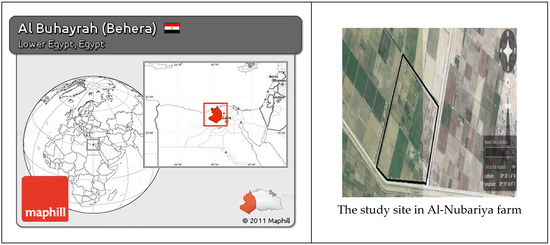
Figure 1.
The study site, Al-Nubariya Region, Egypt, (latitude 30°26′28″ N, longitude 30°18′0″ E) Egypt, (Source: http://www.maphill.com/egypt/lower-egypt/al-buhayrah-behera/location-maps/blank-map/) in 15 January 2023.

Figure 2.
Variables of the monthly environmental conditions during the two growing seasons at the research site.
2.2. Aspects of the Soil’s Physical and Chemical Makeup and Irrigation Water
Fresh irrigation water from a channel that went through the farm and experimental area was used in drip irrigation systems with solenoid valves to regulate irrigation rotation. The water had an electrical conductivity (EC) of 0.55 dS m−1 and an average pH of 7.6. The soil was determined to be a sandy soil by the mechanical analysis of randomly chosen samples. The main physical and chemical characteristics of the soil were established both in situ and in the lab prior to the experiment’s start, as indicated in Table 1.

Table 1.
The soil’s physical and chemical properties in the experiment area.
2.3. Irrigation Requirements for Lemon
Equation (1) was used to compute the daily irrigation water and the seasonal irrigation water for 2021 and 2022 [42]:
where Kc is Crop factor (FAO-56, FAO 56 [43]); ETO is Reference evapotranspiration in mm/day (Figure 3); and IRg is Gross irrigation requirements in mm/day. The Keller equation’s estimated ground reduction factor Kr and Kr values were as follows: (1 − GC%) Kr = GC% + 0.15, where the amount of shade per plant/amount of plant ground cover (%GC); Efficiency of irrigation (Ei), % R is the amount of water a plant receives from sources besides irrigation (for example, rainfall) in millimeters (mm); and LR is the amount of water required for salt leaching in millimeters. For seasons 2021 and 2022, the total water volumes were 7600 m3/ha/season and 7560 m3/ha/season, respectively.
IRg = ((ETo × Kc × Kr)/Ei) − R + LR

Figure 3.
Calculating ETo using a local weather station in the study area.
2.4. Experimental Design
Three replicates of a split plot design were used to set up the experiment. The main plots included manual irrigation (MI) and automatic control of irrigation (AI). Four methods for scheduling mineral fertilization frequencies, i.e., and FF3—three times per season; FF6—six times per season, FF9—nine times per season, FF12—12 times per season, were applied to the sub-main plot, as shown in Figure 4 and Table 2. The distribution of the number of fertilization times during the period from flowering to production was once every month.
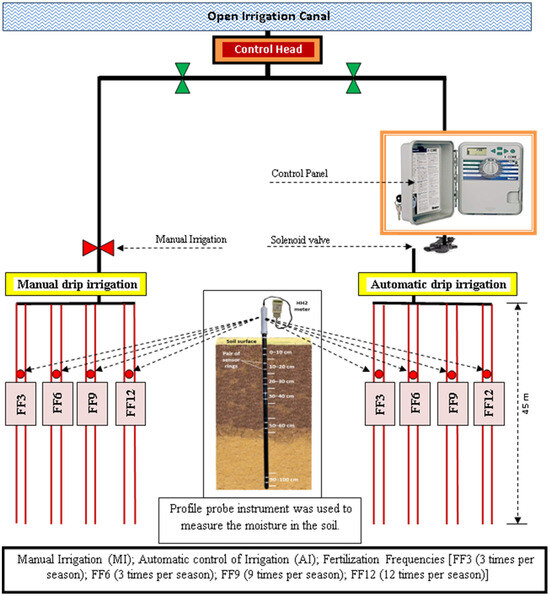
Figure 4.
Layout of the experimental design.

Table 2.
The recommended doses of fertilizers for lemon trees were applied according to the experimental design to all treatment; given in kg per hectare per year.
2.5. Fertilizer Addition
Recommended doses of NPK were applied to all treatments according to the recommendation of the Ministry of Agriculture for lemon trees under drip irrigation, as shown in Table 2.
2.6. Evaluation Parameters
2.6.1. Lemon Tree Roots Under Water Stress
According to the authors of [42], the field capacity and wilting point were taken into account as evaluation parameters for the water stress (WS) exposure range of tree roots. Prior to watering, the soil moisture in the effective roots zone was checked. Measurements were made at mid-growth stage soil depths, i.e., up to 90 cm. A profile probe instrument was used to measure the moisture in the soil.
2.6.2. Water Application Efficiency
When discussing the water application efficiency (WAE), it is important to note that it refers here to the water requirements of lemon plants, whereby the real amount of irrigation water that is held in the root zone is expanding. The authors of [44] applied Equation (2) to determine WAE:
where WAE = water application efficiency, (%), Ds = calculated root zone water storage depth (cm), and Ds = (θ1 − θ2) × d × σ, where θ1 denotes the moisture content of the soil after irrigation, σ denotes the relative bulk density of soil (dimensionless), θ2 denotes the moisture content of the soil before irrigation, and d denotes the depth of the soil layer.
WAE, % = (Ds/Da) × 100
2.6.3. Tree Canopy Volume
Tree canopy volume (TCV), as shown in Figure 5, was determined by measuring the average canopy width in the east–west and north–south directions and the canopy height. TCV was measured at the beginning (February or March) of the experiment and every 6 months thereafter (August or September) from 2021 to 2022. Canopy volume was computed using the formula for a prolate spheroid [45,46] as follows (3):
where TCV (m3) = tree canopy volume, r = mean canopy radius (m), and h = canopy height (m).
TCV = (2/3) πr2 h
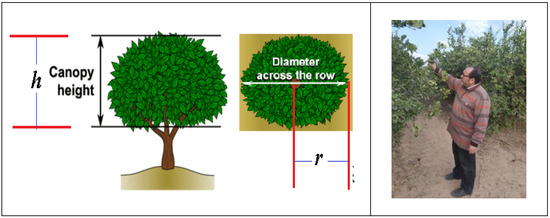
Figure 5.
Method for estimating tree canopy volume of lemon trees.
2.6.4. Lemon Yield and % Difference in Yield
At harvest time, the lemon fruits were gathered and weighed. Then, the fruit production for each treatment was computed using tons per hectare, and % difference in yield was calculated using Equation (4):
% Difference in yield = Value of any treatment − value of control treatment/value of control treatment × 100
2.6.5. Water Productivity of Lemon
As proposed in [47], Equation (5) was used to determine the water productivity of lemon (WPLemon) as follows:
where Ir is the applied irrigation water volume (m3water per hectare per season), Ey is the economical yield (kg per hectare), and WPLemon is the water productivity of lemon (kg lemon/m3water).
WP Lemon = Ey/(Ir)
2.6.6. Irrigation Water Savings
Irrigation water savings (IWSs) were calculated by comparing the percentage of water required to produce one kilogram of the main crop using the Equation (6):
where IWS is irrigation water saving, %; WPT is the water productivity of lemon for any treatment (kg m−3), and WPC is the value of water productivity of lemon for control treatment.
IWS = (WPT − WPC)/WPC) × 100
2.6.7. Quality Traits of Lemon
Representative samples of lemon fruits were randomly chosen from each treatment to determine some of the quality parameters fruits, such as Fruit Diameter (cm). The method described in [48] was used to measure total soluble solids (TSS), vitamin C, fruit weight (in grams), and peel thickness (in centimeters).
2.7. Statistical Analysis
The MSTATC program (version 6.1) was used to analyze the experimental data from the two seasons of the study. Significant differences between means were determined using Fisher’s Least Significant Difference (LSD) test at p = 0.05.
3. Results and Discussion
3.1. Water Stress of Lemon Tree Roots
Soil moisture content (SMC) was investigated before irrigation directly and during the growing seasons under MI and AI, as well as with different fertilization frequencies for lemon production.
Figure 6 shows that the values of SMC just before irrigation were higher with the application of automatic control in the irrigation process compared to manual irrigation. This may have been due to the accuracy of the automatic irrigation, which maintained a regular addition of irrigation water at specific times according to the automatic control panel, i.e., as no intervention was required, there were no errors due to the human element.
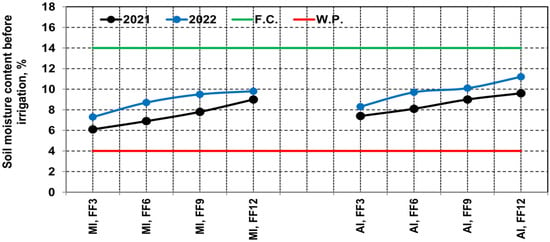
Figure 6.
Effect of automatic control of irrigation and fertilization frequencies on water stress in the roots zone of lemon trees during seasons of 2021 and 2022.
Figure 6 also shows that by increasing the number of fertilization times, the moisture content values increased just before irrigation. This may have been due to the increase in the volume of wet soil with the increase in the number of times of fertilization as a result of the increase in the horizontal movement of water compared to vertical movement. This led to an increase in the volume of wet soil for the root spreading area, which meant an increase in the values of moisture content and a decrease in water stress in the area of the spread of lemon tree warts.
Figure 6 shows that the highest SMC values were when irrigation water was added by automatic control and when fertilizers were applied 12 times during the growing season.
3.2. Application Efficiency of Irrigation Water
The application efficiency of irrigation water (AEIW) was investigated before and after irrigation under MI and AI, as well as with different fertilization frequencies.
Figure 7 shows that the values of the irrigation water addition efficiencies were higher with the application of automatic control in the irrigation process compared to manual irrigation. This may have been due to the fact that the automatic irrigation was accurately added to the irrigation water in a specific amount according to the automatic control panel, and as such, human errors were avoided.
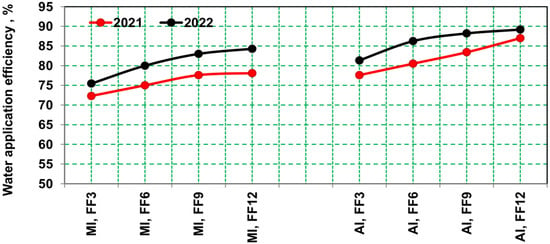
Figure 7.
Effect of automatic control of irrigation and fertilization frequency on water application efficiency at peak of irrigation in the 2021 and 2022 growing seasons.
Figure 7 also shows that with an increase in the number of fertilization times, the value of the efficiencies of the addition to the irrigation water increased. This may have been due to the increase in the volume of wet soil with the increase in the number of fertilization times as a result of the increase in the horizontal movement of water compared to the vertical movement. This led to an increase in the volume of wet soil for the area of root spread, which meant an increase in the values of stored moisture content compared to the size of the addition.
Figure 7 shows that the highest values of irrigation water addition efficiency were when irrigation water was added by automatic control and when fertilizers were applied 12 times during the growing season.
3.3. NPK Concentration in Soil
The effect of automatic irrigation and the frequency of fertilization application on the concentration of macronutrients was studied, as demonstrated by the data presented in Figure 8, Figure 9 and Figure 10.
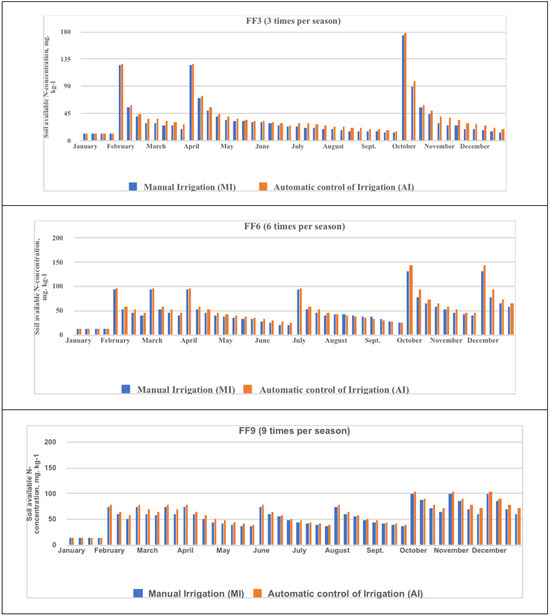

Figure 8.
Effect of automatic control of irrigation and fertilization frequencies on the N concentration in sandy soil.
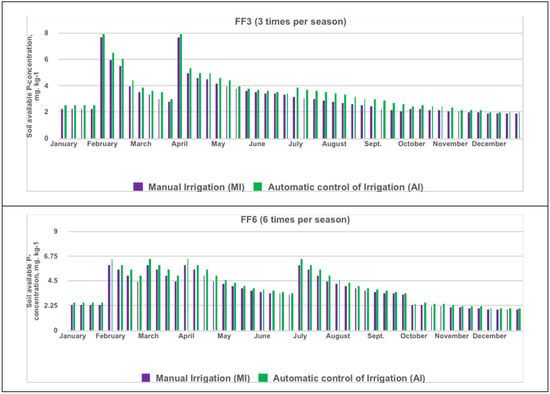
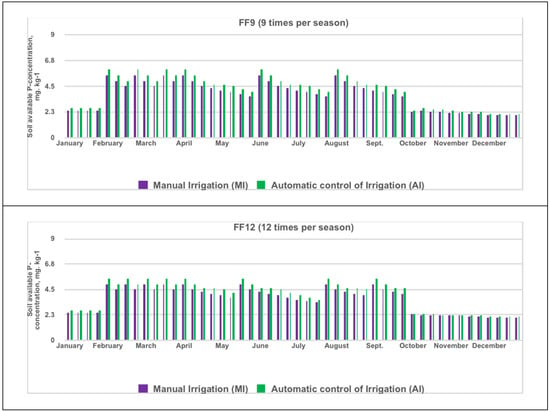
Figure 9.
Effect of automatic control of irrigation and fertilization frequencies on the P concentration in soil.
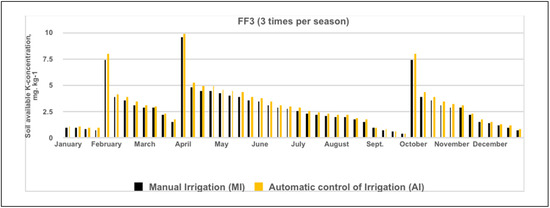
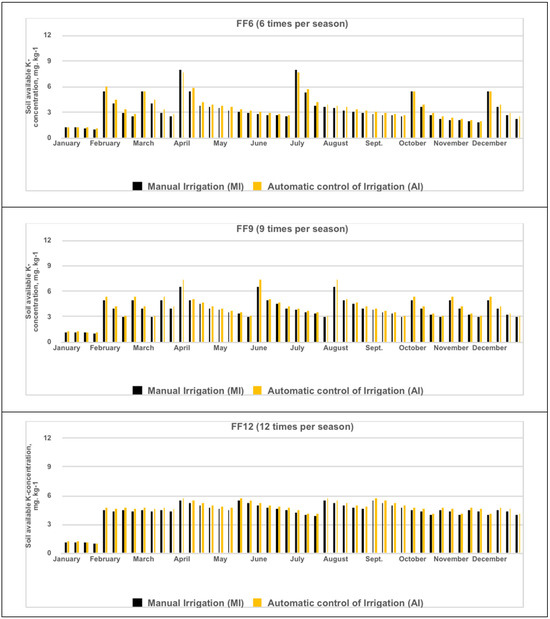
Figure 10.
Effect of automatic control of irrigation and fertilization frequencies on the K concentration in soil.
Macronutrient (NPK) concentrations in the root zone increased with automatic irrigation compared to manual irrigation. This was due to the precise addition of irrigation water in the appropriate amount, which prevented the addition of excess water. This was in contrast to what happened with manual irrigation, i.e., a decrease in the concentration of nutrients lost with excess irrigation water through deep seepage below the root zone of lemon trees planted in sandy soils.
The data presented in Figure 8, Figure 9 and Figure 10 confirm the importance of the frequency of fertilization application in increasing NPK concentrations. Fertilization frequency increased and balanced the concentration of nutrients in the root zone, maintaining them and preventing them from being easily lost in sandy soils throughout the growth period. This increased the ability of lemon tree roots to absorb these macronutrients to the greatest possible extent.
As noted in Figure 8, Figure 9 and Figure 10, when studying the interaction between the study factors relative to the effect of both automatic irrigation and the frequency of fertilization, the best values for the balance of the concentration of major elements throughout the growth period of lemon trees were achieved with automatic irrigation and 12-time fertilization.
3.4. Tree Canopy Volume
Tree canopy volume can be used to evaluate crop development, vigor, and yield potential, where trees with a larger TCV produce more fruit than smaller canopy volumes [49].
Table 3 shows that the TCV values were higher with the application of automatic control in the irrigation process compared to manual irrigation. This may have been due to the fact that the automatic irrigation was accurately added to the irrigation water in a specific amount according to the automatic control panel.

Table 3.
Effect of the automatic control of irrigation and fertilization frequencies on the tree canopy volume of lemon.
Table 3 also shows that with an increase in the number of fertilization times, the TCV values increased. This may have been due to the increase in the volume of wet soil with the increase in the number of times of fertilization as a result of the increase in the horizontal movement of water compared to the vertical movement. This led to an increase in the volume of wet soil for the area of root spread, which meant an increase in the values of stored moisture content compared to the volume of water added.
Table 3 shows that the highest TCV values were recorded when adding irrigation water by automatic control and when adding fertilizers 12 times during the growing season. This result may have been due to the fact that the secondary macronutrients significantly improved the root length density and leaf area index of the treated trees compared with the control trees [50]. A positive linear relationship between tree biomass and N weight to TCV was detected, inferring a steady rate of tissue accumulation with increasing tree size [51].
3.5. Lemon Yield and % Difference in Yield
Productivity is the most important criterion for evaluating the impact of any factor. Figure 11 and Table 4 show that the lemon yield (LY) values were higher with the application of automatic control in the irrigation process compared to manual irrigation. This may have been due to the fact that the automatic irrigation was accurately added to the irrigation water in a specific amount according to the automatic control panel. Automatic irrigation led to a decrease in water stress and an increase in the efficiency of adding irrigation water, which led to an increase in the water absorption rate and thus an increase in the green cover of lemon trees and an improvement in the photosynthesis process. This ultimately led to increased productivity values compared to manual irrigation. These results are in agreement with those presented in [23,24,25,26,27,28].
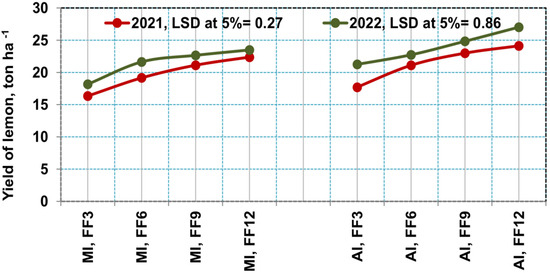
Figure 11.
Effect of automatic control of irrigation and fertilization frequency on the yield of lemon during the 2021 and 2022 seasons.

Table 4.
Effect of automatic control of irrigation and fertilization frequencies on the yield, water productivity of lemon, and irrigation water savings.
Figure 11 and Table 4 also show that with an increase in the number of fertilization times, the LY values increased. This was probably due to the increase in the absorption of the major fertilizer elements as a result of the increase in the concentration and duration of fertilizers in the sandy ground for the longest possible period.
Figure 11 and Table 4 show that the highest LY values were recorded when adding irrigation water with automatic control and when applying fertilizers 12 times during the growing season instead of only three times.
Figure 12 and Table 4 confirm that the highest rate of increase in productivity was 47.6% during the first season and 48.7% during the second season. This significant increase was reached by relying on the automatic irrigation method and increasing the frequency of mineral fertilization times to 12 times.
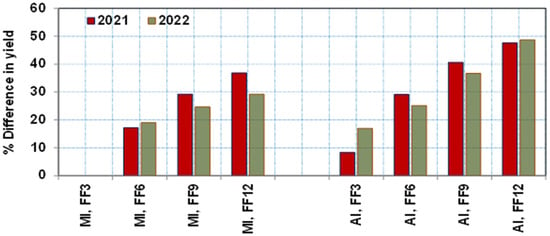
Figure 12.
The effect of the automatic control of irrigation and frequency of fertilization on the rate of increase in yield (% Difference in yield).
3.6. Lemon Water Productivity and Irrigation Water Saving
The value of productivity of any crop is estimated by the productivity of a unit of water from this crop. Given that the amount of water added was equal with all treatments, the changes in the water productivity values were due to the change in the productivity values only, i.e., the same reasons that positively affected the increase in productivity. The highest values of water productivity were obtained when controlling the addition of irrigation water automatically and when adding fertilizers 12 times, as shown in Figure 13 and Table 4.
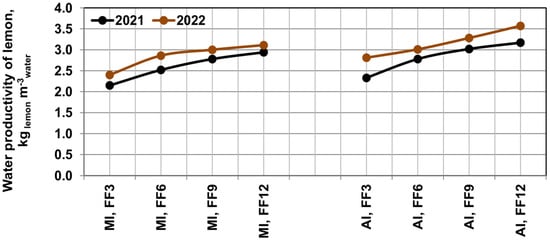
Figure 13.
Effect of the automatic control of irrigation and fertilization frequency on the water productivity of lemon during the 2021 and 2022 seasons.
The effect of automatic irrigation and the frequency of fertilization application on irrigation water savings was studied, as demonstrated in Figure 14.
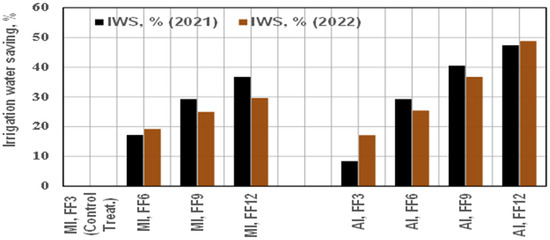
Figure 14.
Effect of the automatic control of irrigation and fertilization frequencies on irrigation water saving during the 2021 and 2022 seasons.
Water savings were higher with automatic irrigation compared to manual irrigation. This was due to the precise amount and timing of irrigation, which created less water stress conditions within the root zone. This positively impacted lemon productivity compared to manual irrigation.
The data presented in Figure 14 also confirm the importance of the frequency of fertilization application in increasing water savings. Repeated fertilization increased and balanced the concentration of nutrients in the root zone, preserving them and preventing their loss in sandy soils. This led to increased lemon productivity and, consequently, increased irrigation water savings.
As observed from Figure 14 in general, the highest water savings were achieved with automatic irrigation and fertilization applied 12 times during the lemon growing season.
3.7. Lemon Fruit Quality
By studying the effect of the automatic irrigation method and the effect of increasing the number of times of mineral fertilization under sandy soil conditions, the positive effect of both factors on all the values of the quality characteristics under study was clear.
Through the data presented in the Table 5 and Table 6 and Figure 15 and Figure 16, it was found that the values of the quality characteristics of the fruits and lemon juice were better with the automatic control of the addition of irrigation water, as this method led to an improvement in the conditions of the root spreading area, an increase in the efficiency of the addition of irrigation water, and a decrease in water stress. These factors led to an increase in the absorption of nutrients and, consequently, an improvement in the quality characteristics and productivity values.

Table 5.
Effect of the automatic control of irrigation and fertilization frequency on fruit diameter, peel thickness, and fruit weight of lemon.

Table 6.
Effect of the automatic control of irrigation and fertilization frequency on the total soluble solids (T.S.S.) and vitamin C level of lemon.
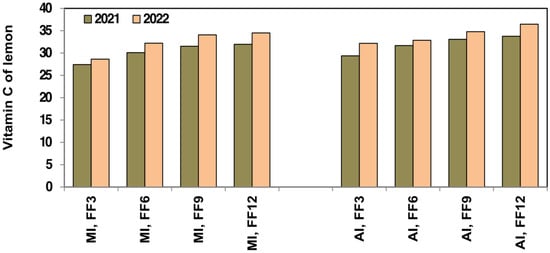
Figure 15.
Effect of the automatic control of irrigation and fertilization frequency on the vitamin C content of lemon during the 2021 and 2022 seasons.
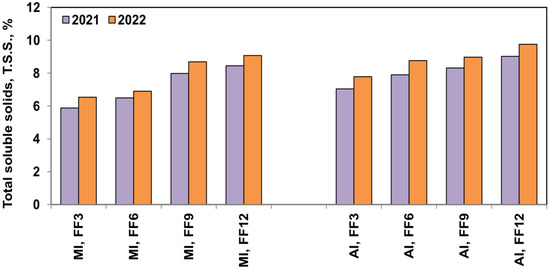
Figure 16.
Effect of the automatic control of irrigation and fertilization frequency on the total soluble solids of lemon during the 2021 and 2022 seasons.
The data presented in the Table 5 and Table 6 and Figure 15 and Figure 16 show the positive effect of increasing the number of fertilization times during the two growing seasons. This may also have been due to the increase in the concentration and the period of presence of these major elements, i.e., as long as possible in the area where the roots were spread, especially with sandy soil conditions.
Through the positive effect of the study factors on the increase and improvement of all lemon quality traits, it became clear that the highest values of the quality traits were achieved through automatic controlled irrigation with the highest number of fertilizer applications.
4. Conclusions
This study has emphasized the importance of applying and controlling the addition of irrigation water automatically as a sustainable alternative to manual irrigation, while increasing the number of mineral fertilization times to the largest possible number (12 times during the growing season of lemon trees).
The application of automatic irrigation reduced the water stress on the roots, in addition to increasing the efficiency of the addition, which led to the creation of a healthy environment in the area where the roots spread and increased the rate of absorption of irrigation water and the necessary major elements. Accordingly, the turf of the lemon trees increased in size, which led to an improvement in the efficiency of the photosynthesis process, resulting in an increase and improvement of water productivity and quality characteristics of lemon trees in sandy soils in a dry area.
Increasing the number of times of mineral fertilization to 12 during the growing season led to an increase in the concentration and the period of presence of these fertilizers.
The highest values of the productivity and irrigation water saving were 47.6% and 47.4%, respectively, during the first season and 48.7% and 48.8% during the second. The highest values of water productivity and lemon fruit quality were also achieved under the same conditions. Therefore, based on this study, the automatic control of irrigation schedules, in addition to increasing the frequency of fertilization are recommended, not only in lemon plantations, but also for other horticultural fruit trees grown on dry sandy lands. It was observed that using automated irrigation and increased fertilization under organic farming conditions in sandy soils could become a sustainable technique for reducing water and fertilization stress in the root zone, increasing and improving crop productivity and addressing climate change, horticulture in arid conditions, and irrigation water scarcity.
Author Contributions
Conceptualization, A.R.E., B.M.M.B. and H.H.H.T.; methodology, A.R.E., B.M.M.B., M.A.E.-S., M.A.A.A., W.M.E.F. and M.F.; software, B.M.M.B., M.A.E.-S., M.A.A.A., W.M.E.F. and M.F.; validation, A.R.E., K.A.M. and H.H.H.T.; formal analysis, A.R.E., B.M.M.B., M.A.E.-S., M.A.A.A., W.M.E.F. and M.F.; investigation, A.R.E., K.A.M. and H.H.H.T.; resources, A.R.E., B.M.M.B. and B.M.A.A.; data curation, B.M.M.B., M.A.E.-S., M.A.A.A., W.M.E.F. and M.F.; writing—original draft preparation, A.R.E., B.M.A.A. and K.A.M.; writing—review and editing, A.R.E., B.M.A.A. and K.A.M.; visualization, A.R.E., B.M.M.B., B.M.A.A. and H.H.H.T.; supervision, A.R.E., B.M.A.A., K.A.M. and H.H.H.T.; project administration, A.R.E., B.M.A.A. and K.A.M.; funding acquisition, B.M.A.A. and K.A.M. All authors have read and agreed to the published version of the manuscript.
Funding
This work was supported by the Deanship of Scientific Research, Vice Presidency for Graduate Studies and Scientific Research, King Faisal University, Saudi Arabia [Project No. KFU251381].
Data Availability Statement
All data and materials are included in the paper.
Acknowledgments
Authors are extending their sincere thanks to the Deanship of Scientific Research, Vice Presidency for Graduate Studies and Scientific Research, King Faisal University, Saudi Arabia.
Conflicts of Interest
The authors declare no conflicts of interest.
References
- Abdelraouf, R.E.; El-Shawadfy, M.A.; Ghoname, A.A.; Ragab, R. Improving Crop Production and Water Productivity Using a New Field Drip Irrigation Design. Plant Arch. 2020, 20, 3553–3564. [Google Scholar]
- Abdelraouf, R.E.; Okasha, E.M.; Tarabye, H.H.H. Modified Design for Drip Irrigation System to Improve the Productivity of Irrigation Water and Fertilizers Distribution. Int. J. Chemtech Res. 2016, 9, 40–52. [Google Scholar]
- Abdelraouf, R.E. Reuse of Fish Farm Drainage Water in Irrigation. In Unconventional Water Resources and Agriculture in Egypt; Springer: Cham, Switzerland, 2017; pp. 393–410. [Google Scholar]
- Abdelraouf, R.E.; Azab, A.; Tarabye, H.H.H.; Refaie, K.M. Effect of Pulse Drip Irrigation and Organic Mulching by Rice Straw on Yield, Water Productivity and Quality of Orange under Sandy Soils Conditions. Plant Arch. 2019, 19, 2613–2621. [Google Scholar]
- Eid, A.R.; Fathy, M.; El-Sayed, A.; Hafez, M.; El Shirbeny, M.A.; Reda, A.M.; Mady, A.Y. Validation of SALTMAD Model for Simulating Soil Moisture and Faba Bean Productivity under Deficit Irrigation and Integrated Fertilization in the Semi-Arid Regions. Soil Environ. 2023, 42, 111–129. [Google Scholar] [CrossRef]
- Dewedar, O.M.; El-Shafie, A.F.; Marwa, M.A.; Abdelraouf, R.E. Improvement of Irrigation Water Management Using Simulation Models And Artificial Intelligence Under Dry Environment Conditions in Egypt: A Review. Egypt. J. Chem. 2023, 66, 93–106. [Google Scholar]
- Eid, A.R.; Negm, A. Improving Agricultural Crop Yield and Water Productivity via Sustainable and Engineering Techniques. In Conventional Water Resources and Agriculture in Egypt; Springer: Berlin/Heidelberg, Germany, 2019; pp. 561–591. [Google Scholar]
- Geerts, S.; Raes, D. Deficit Irrigation as an On-Farm Strategy to Maximize Crop Water Productivity in Dry Areas. Agric. Water Manag. 2009, 96, 1275–1284. [Google Scholar] [CrossRef]
- Abdelbaset, M.M.; Dewedar, O.; Ramadan, A.; El-Shafie, A.F. Precision Irrigation Management Using Automatic Scheduling Techniques under Environmental Drought Stress Conditions in Egypt: A Review. Egypt. J. Chem. 2023, 66, 403–413. [Google Scholar]
- Abdelraouf, R.E.; El-Shawadfy, M.A.; Dewedar, O.M.; Hozayn, M. Improving Yield and Water Productivity of Canola under Sprinkler Irrigation and High Frequency of N-Fertigation. Asian J. Plant Sci. 2021, 20, 143–156. [Google Scholar] [CrossRef]
- Liu, Z.; Xu, Q. Wetting Patterns Estimation in Cultivation Substrates under Drip Irrigation. Desalination Water Treat. 2018, 112, 319–324. [Google Scholar] [CrossRef]
- Karimi, B.; Mohammadi, P.; Sanikhani, H.; Salih, S.Q.; Yaseen, Z.M. Modeling Wetted Areas of Moisture Bulb for Drip Irrigation Systems: An Enhanced Empirical Model and Artificial Neural Network. Comput. Electron. Agric. 2020, 178, 105767. [Google Scholar] [CrossRef]
- Abdelraouf, R.E.; Ghanem, H.G.; Bukhari, N.A.; El-Zaidy, M. Field and Modeling Study on Manual and Automatic Irrigation Scheduling under Deficit Irrigation of Greenhouse Cucumber. Sustainability 2020, 12, 9819. [Google Scholar] [CrossRef]
- Yao, W.W.; Ma, X.Y.; Li, J.; Parkes, M. Simulation of Point Source Wetting Pattern of Subsurface Drip Irrigation. Irrig. Sci. 2011, 29, 331–339. [Google Scholar] [CrossRef]
- Kandelous, M.M.; Šimůnek, J. Numerical Simulations of Water Movement in a Subsurface Drip Irrigation System under Field and Laboratory Conditions Using HYDRUS-2D. Agric. Water Manag. 2010, 97, 1070–1076. [Google Scholar] [CrossRef]
- Moncef, H.; Khemaies, Z. An Analytical Approach to Predict the Moistened Bulb Volume beneath a Surface Point Source. Agric. Water Manag. 2016, 166, 123–129. [Google Scholar] [CrossRef]
- Nazari, B.; Liaghat, A.; Akbari, M.R.; Keshavarz, M. Irrigation water management in Iran: Implications for water use efficiency improvement. Agric. Water Manag. 2018, 208, 7–18. [Google Scholar] [CrossRef]
- Abioye, E.A.; Abidin, M.S.Z.; Mahmud, M.S.A.; Buyamin, S.; Ishak, M.H.I.; Abd Rahman, M.K.I.; Otuoze, A.O.; Onotu, P.; Ramli, M.S.A. A Review on Monitoring and Advanced Control Strategies for Precision Irrigation. Comput. Electron. Agric. 2020, 173, 105441. [Google Scholar] [CrossRef]
- Abdelraouf, R.E.; El-Shawadfy, M.; Fadl, A.; Bakr, B. Effect of Deficit Irrigation Strategies and Organic Mulching on Yield, Water Productivity and Fruit Quality of Navel Orange under Arid Regions Conditions. Plant Arch. 2020, 20, 3505–3518. [Google Scholar]
- Mason, B.; Rufí-Salís, M.; Parada, F.; Gabarrell, X.; Gruden, C. Intelligent Urban Irrigation Systems: Saving Water and Maintaining Crop Yields. Agric. Water Manag. 2019, 226, 105812. [Google Scholar] [CrossRef]
- Pereira, L.S.; Paredes, P.; Jovanovic, N. Soil Water Balance Models for Determining Crop Water and Irrigation Requirements and Irrigation Scheduling Focusing on the FAO56 Method and the Dual Kc Approach. Agric. Water Manag. 2020, 241, 106357. [Google Scholar] [CrossRef]
- Bwambale, E.; Abagale, F.K.; Anornu, G.K. Smart Irrigation Monitoring and Control Strategies for Improving Water Use Efficiency in Precision Agriculture: A Review. Agric. Water Manag. 2022, 260, 107324. [Google Scholar] [CrossRef]
- Lozano, D.; Ruiz, N.; Baeza, R.; Contreras, J.I.; Gavilán, P. Effect of Pulse Drip Irrigation Duration on Water Distribution Uniformity. Water 2020, 12, 2276. [Google Scholar] [CrossRef]
- Smarsly, K. Agricultural Ecosystem Monitoring Based on Autonomous Sensor Systems. In Proceedings of the 2013 Second International Conference on Agro-Geoinformatics (Agro-Geoinformatics), Fairfax, VA, USA, 12–16 August 2013; pp. 402–407. [Google Scholar]
- Luquet, D.; Vidal, A.; Smith, M.; Dauzat, J. More crop per drop’: How to make it acceptable for farmers? Agric. Water Manag. 2005, 76, 108–119. [Google Scholar] [CrossRef]
- Maller, A.; Rezende, R.; de Freitas, P.S.L.; Seron, C.C.; Hachmann, T.L. Moisture in the Soil Profile with Water Applications Using Pulse Drip Irrigation. Rev. Ciênc. Agron. 2019, 50, 234–241. [Google Scholar] [CrossRef]
- Atia, R.H.; Hamoud, H.S.; El–Saady, A.S.M. Effect of (Halex-2) biofertilizer inoculation on cowpea yield and mineral fertilization-N optimization. J. Soil Sci. Agric. Eng. 2009, 34, 5487–5495. [Google Scholar] [CrossRef]
- Liu, J.L.; Chen, F.; Olokhnuud, C.; Glass, A.D.M.; Tong, Y.; Zhang, F.; Mi, G. Root size and nitrogen-uptake activity in two maize (Zea mays) inbred lines differing in nitrogen-use efficiency. J. Plant Nutr. Soil Sci. 2010, 172, 230–236. [Google Scholar] [CrossRef]
- Azizian, A.; Sepaskhah, A.R. Maize response to different water, salinity and nitrogen levels yield-water relation, water-use and water uptake reduction function. Int. J. Plant Prod. 2014, 8, 183–214. [Google Scholar]
- de Almeida, W.F.; Lima, L.A.; Pereira, G.M. Drip Pulses and Soil Mulching Effect on American Crisphead Lettuce Yield. Eng. Agríc. 2015, 35, 1009–1018. [Google Scholar] [CrossRef]
- Sitthaphanit, S.; Limpinuntana, V.; Toomsan, B.; Panchaban, S.; Bell, R.W. Fertiliser Strategies for Improved Nutrient Use Efficiency on Sandy Soils in High Rainfall Regimes. Nutr. Cycl. Agroecosyst. 2009, 85, 123–139. [Google Scholar] [CrossRef]
- Nyamangara, J.; Bergström, L.F.; Piha, M.I.; Giller, K.E. Fertilizer Use Efficiency and Nitrate Leaching in a Tropical Sandy Soil. J. Environ. Qual. 2003, 32, 599–606. [Google Scholar] [CrossRef]
- Abdelraouf, R.E.; Ragab, R. Effect of Fertigation Frequency and Duration on Yield and Water Productivity of Wheat: Field and Modelling Study Using the Saltmed Model. Irrig. Drain. 2018, 67, 414–428. [Google Scholar] [CrossRef]
- Eghball, B.; Binford, G.D.; Baltensperger, D.D. Phosphorus movement and adsorption in a soil receiving long-term manure and fertilizer application. J. Environ. Qual. 1996, 25, 1339–1343. [Google Scholar] [CrossRef]
- Alfaro, M.A.; Jarvis, S.C.; Gregory, P.J. Factors Affecting Potassium Leaching in Different Soils. Soil Use Manag. 2004, 20, 182–189. [Google Scholar] [CrossRef]
- Bessou, C.; Verwilghen, A.; Beaudoin-Ollivier, L.; Marichal, R.; Ollivier, J.; Baron, V.; Bonneau, X.; Carron, M.P.; Snoeck, D.; Naim, M.; et al. Agroecological practices in oil palm plantations: Examples from the field. OCL 2017, 24, D305. [Google Scholar] [CrossRef]
- Hoffmann, M.P.; Donough, C.R.; Cook, S.E.; Fisher, M.J.; Lim, C.H.; Lim, Y.L.; Cock, J.; Kam, S.P.; Mohanaraj, S.N.; Indrasuara, K.; et al. Yield Gap Analysis in Oil Palm: Framework Development and Application in Commercial Operations in Southeast Asia. Agric. Syst. 2017, 151, 12–19. [Google Scholar] [CrossRef]
- Pirker, J.; Mosnier, A.; Kraxner, F.; Havlík, P.; Obersteiner, M. What Are the Limits to Oil Palm Expansion? Glob. Environ. Change 2016, 40, 73–81. [Google Scholar] [CrossRef]
- Donough, C.R.; Witt, C.; Fairhurst, T.H. Yield intensification in oil palm using BMP as a management tool. In International Conference on Oil Palm and the Environment; International Plant Nutrition Institute (IPNI): Penang, Malaysia, 2010; pp. 23–27. [Google Scholar]
- Pardon, L.; Huth, N.I.; Nelson, P.N.; Banabas, M.; Gabrielle, B.; Bessou, C. Yield and Nitrogen Losses in Oil Palm Plantations: Main Drivers and Management Trade-Offs Determined Using Simulation. Field Crops Res. 2017, 210, 20–32. [Google Scholar] [CrossRef]
- Foster, H.L.; Dolmat, M. The effect of different methods of placement and frequency of application of fertiliser to oil palm on an inland soil in Peninsula Malaysia. PORIM Bull. 1986, 12, 1–11. [Google Scholar]
- Abdelraouf, R.E.; Abbas, S.M.M.; Mahmoud Abbas, M.M.; Hafez, M.; Popov, A.I.; Hamed, L. Influence of N-Fertigation Stress and Agro-Organic Wastes (Biochar) to Improve Yield and Water Productivity of Sweet Pepper Under Sandy Soils Conditions. Plant Arch. 2020, 20, 3208–3217. [Google Scholar]
- El-Meseery, A.A. Effect of Different Drip Irrigation Systems on Maize Yield in Sandy Soil. In Proceedings of the 11th Annual Conference of Misr Society of Agricultural Engineering, Kafr El-Sheikh, Egypt, 15–16 October 2003; pp. 15–16. [Google Scholar]
- Allen, R.G.; Pereira, L.S.; Raes, D.; Smith, M. Crop Evapotranspiration-Guidelines for Computing Crop Water Requirements-FAO Irrigation and Drainage Paper 56; FAO: Rome, Italy, 1998. [Google Scholar]
- Kadyampakeni, D.M.; Morgan, K.T.; Schumann, A.W. Biomass, Nutrient Accumulation and Tree Size Relationships for Drip-and Microsprinkler-Irrigated Orange Trees. J. Plant Nutr. 2016, 39, 589–599. [Google Scholar] [CrossRef]
- Obreza, T.A.; Rouse, R.E. Fertilizer effects on early growth and yield of ‘Hamlin’ orange trees. HortScience 1993, 28, 111–114. [Google Scholar] [CrossRef]
- James, L.G. Principles of Farm Irrigation System Design; John Willey & Sons. Inc.: Hoboken, NJ, USA, 1988; Volume 73, pp. 350–351. [Google Scholar]
- Singh, J.P. A Rapid Method for Determination of Nitrate in Soil and Plant Extracts. Plant Soil 1988, 110, 137–139. [Google Scholar] [CrossRef]
- Colaço, A.F.; Trevisan, R.G.; Molin, J.P.; Rosell-Polo, J.R.; Escola, A. Orange tree canopy vlume estimation by manual LiDAR-basd methods. Adv. Anim. Biosci. 2017, 8, 477–480. [Google Scholar] [CrossRef]
- Atta, A.A.; Morgan, K.T.; Mahmoud, K.A. Split Application of Nutrients Improve Growth and Yield of Huanglongbing-Affected Citrus Trees. Soil Sci. Soc. Am. J. 2021, 85, 2040–2053. [Google Scholar] [CrossRef]
- Morgan, K.; Scholberg, J.; Obreza, T.; Wheaton, T. Size, Biomass, and Nitrogen Relationships with Sweet Orange Tree Growth. J. Am. Soc. Hortic. Sci. 2006, 131, 149–156. [Google Scholar] [CrossRef]
Disclaimer/Publisher’s Note: The statements, opinions and data contained in all publications are solely those of the individual author(s) and contributor(s) and not of MDPI and/or the editor(s). MDPI and/or the editor(s) disclaim responsibility for any injury to people or property resulting from any ideas, methods, instructions or products referred to in the content. |
© 2025 by the authors. Licensee MDPI, Basel, Switzerland. This article is an open access article distributed under the terms and conditions of the Creative Commons Attribution (CC BY) license (https://creativecommons.org/licenses/by/4.0/).